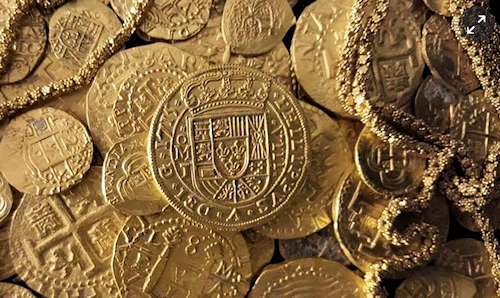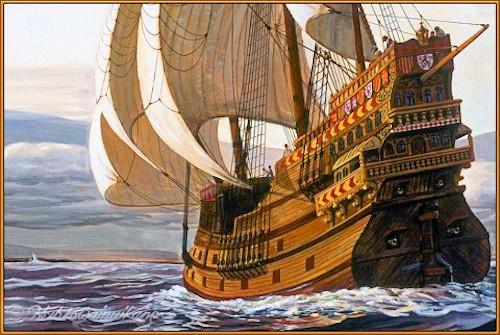Mar dei Carabi 2 November 1641, on this day consecrated by the piety of the living to the cult of the dead, a ship loaded with gold and silver sank with its cargo of men and precious goods. It was certainly not the first nor the last in a series of maritime disasters that occurred in those waters that have always been feared by sailors around the world. Crystalline waters, with shades of fascinating colors, but which hide coral points able to break the most robust keels and on which unpredictable hurricanes unleash, that no ship is able to cope with.
Nuestra Senòra de la Concepcion was the flagship of a small fleet of eight vessels built at Vera Cruz, by Diego Pachego, Duke of Escalona, named 1640, by Philip IV of Spain (1605-1665), viceroy of Mexico. The Spanish naval power has started its descending nemesis, the royal fleet has little more than 25 ships able to make connections with the New World, but the new governor of Mexico soon worked to fill this disgraceful situation at least in part. However, to build up in one year eight galleons and a frigate, Mexican shipyards are an improbable effort, as we shall see, with disastrous consequences on the safety of boats and crews.

The 23 July 1641, the fleet took the sea in the direction of Cuba, where it would meet, before crossing the Atlantic, with the team called "Armada de Barlovento", was a Spanish military institution created to protect the Spanish ships against attacks by pirates, privateers and other European powers. In all 31 ships ready to sail to Europe. They left Havana only the September 13, after parties and dances organized to greet the numerous authorities that were returning to Spain. The cyclone season was almost upon us, a first signal already occurred on the second day of navigation, when the flagship was forced to return precipitously to the port of Cuba because it had the holds full of water. Repaired at best, in just ten days, the Nuestra Senòra de la Concepcion, he resumed the sea to arrive at the hurricane. Three convoy ships collapsed, others crashed against the tip of Florida. Nuestra Senòra de la Concepcion was disarmed by the waves and after a vicious agony, crashed on the coral formation that the Spanish pilots called (Abreojos - keep their eyes open), the most terrible of the whole area, and that for the numerous wrecks of Spanish ships carrying silver to Europe was also called "Silver Bank". Of the 525 people who were aboard the flagship only 200 managed to survive. The gold, the silver, and all the riches that carried it fell apart.
Years passed and the history of the galleon carved with treasures became legend, the pirates and the corpses of the Antilles struggled to look for it, but only William Phips, a Boston carpenter who became a smuggler, and who had known to Hispaniola one of the survivors of the shipwreck he had provided him with a detailed map of the treasure, reached the "Silver Counter" and found the wreck. Not having the means to finance the recovery, he had to travel to London where he found partners to fund the enterprise, entering into a contract that would secure the British crown a tenth of what had been recovered. With two ships, the James and Mary of two hundred tons, armed with twenty - two cannons,Herry of London smaller and faster, he returned to the "Silver Board". It is difficult to describe the efforts that this treasure hunt has brought to ships, sailors and divers, but the result was such that everyone forgot them: ingots and coins, a bonnet full of pearls, rubies, diamonds, jewels, statues and crystal cups ; the treasure repaired the seekers of their labor and the financiers of the employed capital. However, it was known that what had returned to light was only a small part of what the missing galleon was carrying.
 Three centuries later, in July of 1968, another expedition reaches the area of the shipwreck. Jacques Cousteau (1910-1997) with his Calypso the quest for the famous wreck begins. Now you can underwater research with modern and appropriate equipment and instruments. A first find is a cannon, similar to those armed by the gold fleet galleons. Chinese porcelain, numerous pots and cups were then taken, fragile but intact objects. Let us not forget that at the time of the gold fleets, other galleons transported goods from the Philippines that then transhipped to Europe. After weeks of research, a pack of lead seals came to life, it is known that sailors have always put seals on the golden parcels, and this finding would seem to be the most anticipated booty signal, gold. The seals bear lilac flowers, and the lily flower was a common emblem of the French and Spanish. In the end, a lead weight that was used for the scales of the ship was found decisive in the continuation of the shipment. At the time when this type of weight was in use, the Chambers of Commerce of the Great Maritime Nations checked the weights transmitted by the ships every five years and enrolled them over the date of the last inspection: 1756, the date appeared clear, a century too much, the treasure hunt of the Nuestra Senòra de la Concepcion it was over, even the expedition Cousteau had to surrender to reality.
Three centuries later, in July of 1968, another expedition reaches the area of the shipwreck. Jacques Cousteau (1910-1997) with his Calypso the quest for the famous wreck begins. Now you can underwater research with modern and appropriate equipment and instruments. A first find is a cannon, similar to those armed by the gold fleet galleons. Chinese porcelain, numerous pots and cups were then taken, fragile but intact objects. Let us not forget that at the time of the gold fleets, other galleons transported goods from the Philippines that then transhipped to Europe. After weeks of research, a pack of lead seals came to life, it is known that sailors have always put seals on the golden parcels, and this finding would seem to be the most anticipated booty signal, gold. The seals bear lilac flowers, and the lily flower was a common emblem of the French and Spanish. In the end, a lead weight that was used for the scales of the ship was found decisive in the continuation of the shipment. At the time when this type of weight was in use, the Chambers of Commerce of the Great Maritime Nations checked the weights transmitted by the ships every five years and enrolled them over the date of the last inspection: 1756, the date appeared clear, a century too much, the treasure hunt of the Nuestra Senòra de la Concepcion it was over, even the expedition Cousteau had to surrender to reality.
The seas routes, and the treasure hunters, are immutable, like sunrise and sunset; one day someone else will be driven by the fantasy of the gold and the treasure of the Nuestra Senòra de la Concepcion, and will take you to the "Silver Board" in a fierce race for the recovery of its precious cargo. The wreck of the golden galleon is still protected from the ocean, and its treasures lie at the bottom of the sea, and belong to Neptune.
Mario Veronesi
REFERENCES
1) Jacques Cousteau - Sea Planet Science and Adventure Encyclopedia - vol 1-12 - Editorial Group Fabbri Milano 1982
2) Claudio Bonifacio - Galleons and submerged treasures - Mursia 2010
(photo: web)












